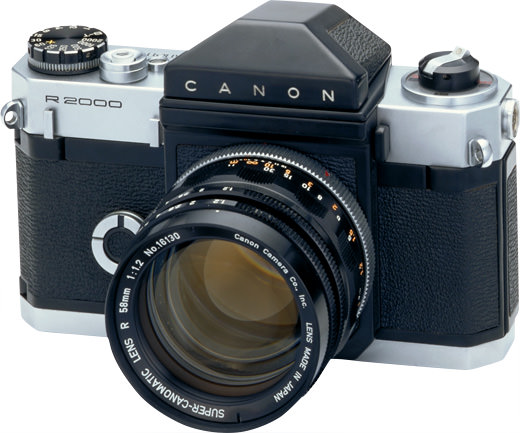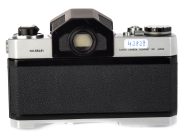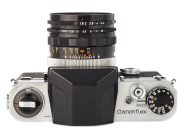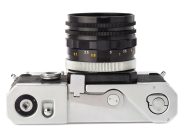Canonflex R2000
35mm MF film SLR camera
Specification
| Production details: | |
| Announced: | September 1960 |
| System: | ● Canon R (1959) |
| Format: | |
| Maximum format: | 35mm full frame |
| Film type: | 135 cartridge-loaded film |
| Mount and Flange focal distance: | Canon R [42mm] |
| Shutter: | |
| Type: | Focal-plane |
| Model: | Mechanical |
| Speeds: | 1 - 1/2000 + B |
| Exposure: | |
| Exposure metering: | None |
| Exposure modes: | Manual |
| Physical characteristics: | |
| Weight: | 690g |
| Dimensions: | 145x100x49mm |
Manufacturer description #1
The new, sensational Canonflex R2000 is a professional-type 35mm single-lens reflex camera of the highest quality. Now, incorporating the fastest shutter speed of 1/2000th of a second, it is designed specially for professionals, serious amateurs... for those who can afford this fine camera.
The Canonflex R2000 incorporates all the precision features for which the name of Canon is pre-eminent in the world of photography. The new "R2000" excels in optical as well as mechanical perfection... making it truly the Ultimate in the high quality and high performance single-lens reflex camera today.
Quick-as-a-wink, Canonflex R2000 features the Super Canonmatic System to let you view and focus with full brightness at all times! The new Canonflex R2000 is easy-to-operate, rugged in construction, and highly functional. With the complete range of photographic aids provided for by Canon, you'll enjoy every phase of photography at its Canon best!
About Super Canonmatic System...
When the Canonflex, the predecessor of Canonflex R2000, was introduced, Canon opened up an entirely new horizon in the photographic concepts and versatilities. Canon's entry in the 35mm single-lens reflex bracket with its fully-automatic springback mirror and diaphragm had rocked the world of photography. It was the first attempt made by high quality camera manufacturers to produce a 35mm single-lens reflex that lets the photographer view and focus with full aperture brightness at all times.
Here's how Super Canonmatic works; As the shutter button is pressed, the mirror snaps up and returns automatically immediately after exposure. Simultaneously, the diaphragm of the Super Canonmatic lens closes down to the pre-selected aperture stop and reopens to full aperture instantly. Thus, viewing and focusing before and after the exposure can be done with full aperture brightness. There's no blackout with the Super Canonmatic System.
This is the Canon-exclusive feature common with all single-lens reflex cameras produced by Canon Camera Company, Inc.
Super Canonmatic Lenses...
A complete range of Super Canonmatic lenses from wide-angle to telephoto are at service for the owners of Canonflex R2000.
The diaphragm of the Super Canonmatic lenses works automatically. As the shutter is released, the diaphragm closes down to the pre-selected aperture stop and then springs back automatically immediately after exposure. These wide range of interchangeable lenses let you cope with almost any photographic sitation.
Complete Range of Photographic Aids...
Canon offers a complete range of photographic aids for use with the new Canonflex R2000. Though Canonflex R2000 is quite versatile in itself, number of photographic aids are provided... for copy work, close-ups, photomacrography, photomicrography... for all phases of photography at its finest.
12 Shutter Speeds from 1 to 1/2000 second...
Now, Canon has successfully completed in incorporating 1/2000th of a second... the fastest shutter speed now available on any camera in the world.
With the development of high speed Super Canonmatic lenses and fast film rating, you can stop almost anything now! The fast Super Canonmatic lenses in combination with 1/2000 second and fast film has opened up a new lane in the world of photography.
You can stop...
The shutter dial of the Canonflex R2000 is on a single-pivot with 12 speed readings - 2000, 1000, 500, 250, 125, 60-X, 30, 15, 8, 4, 2, 1 - equally spaced linear scale plus Bulb-Time exposure. The electronic flash synchronizes at 60-X.
Semi-Automatic Exposure Setting...
Canonflexes R2000, RP have a detachable exposure meter coupled to the shutter speed dial. It is mounted on the front of the camera... and can be used separately. Canon Meter R has the highest sensitivity, gives you accurate exposure reading at all times, and works for an object having light value as low as 4 (LV). This means that this meter will work in poor lighting condition where you have to use 1/4 second at F1.8, with film sensitivity of ASA 100 rating. Canon Meter R can be used in two phases of lighting condition: in poor light as well as in bright light. It is manipulated by the control knob on the side of the meter.
Semi-automatic exposure setting of Canon Meter R lets you adjust the exposure with utmost ease. As the meter indicator is turned to match the pre-set aperture reading to the pointer, the shutter speed is automatically set to the correct exposure time. Conversely, if the shutter is first set, the correct lens aperture will be automatically set. An incident light attachment is provided.
The meter dial is calibrated in both ASA and DIN. With film of ASA 100 rating, the sensitivity range of Canon Meter R is:
Low Sensitivity Range - Light Value - 10-19 lumen
High Sensitivity Range - Light Value - 4-13 lumen.
Easy Viewing and Focusing...
Brightest single-lens reflex viewfinder with high resolving and specially grained unique focusing glass...
Easy viewing...
Canonflex R2000 is single-lens reflex type which enables you to view the scene without parallax error. What is seen through the viewfinder eyepiece is the actual scene recorded on film. The bright viewfinder let you view the object very easily.
Easy Focusing...
Canonflex R2000 incorporates high resolving and specially grained focusing glass. On the high resolving and specially grained ground glass, you can see the sharpest image of subjects by rotating the focusing ring.
Eye-Level Pentaprism, Interchangeable with Waist-Lever Viewer...
For ease in picture taking, viewing and focusing is done normally at eye-level. Pentaprism is interchangeable with the waist-level viewer which can be conveniently used for copy work, when the camera is on tripod, etc. The waist-level viewer has 4-fold magnification. Choose either viewfinder depending on the situation.
Quickest, Trigger-Action Winding... 3 pictures per second!
A single-stroke of the Canonflex R2000 trigger-action lever advances the film, cocks the shutter, counts exposure all in one operation. At the same time, it charges the Super Canonmatic mechanism for automatic operation of springback diaphragm and mirror for the next exposure.
You can take as many as 3 pictures per second! The fool-proof mechanism of Canonflex R2000 prevents accidental advancement on film. The lever cannot be wound unless the shutter is released.
Cordless, Direct Single-Socket for Automatic Flash and Electronic Flash Synchronization
One of the outstanding features of all Canon Cameras... direct single flash socket is incorporated in the new Canonflexes R2000 and RP. Either BC flash unit, or electronic flash unit, is fitted directly to the single bayonet fitting socket on the camera. No troublesome dangling wires to get in your way. The circuit is automatically connected as the unit is attached. Specially fitted cam flash gun, Canon Flash Model V or any regular flash gun, can be used. The setting of the shutter speed dial automatically sets the synchro mechanism with the shutter mechanism for accurate flash timing. The new Canonflexes R2000 and RP can be used with any kind of flash bulb or electronic flash. No further setting or adjustment necessary.
Easy Film Loading and Rewinding...
Loading of film with the new Canonflexes R2000 and RP are extremely easy. It has a foolproof hinged-back. Canonflex R2000 incorporates FILM REWIND CRANK which assures smooth and easy rewinding of film... prevents film from damage.
Anti-Film-Curl Roller...
The new Canonflexes R2000 and RP have ANTI-FILM-CURL ROLLER on the pressure of the back cover. The roller is to prevent curling and warping of film to assure critical focusing even at full aperture of the highest speed lenses where the depth-of-field in focus is extremely shallow.
Easy-to-Read, Film Type and Speed Indicator...
The Canonflexes R2000 and RP have FILM-TYPE INDICATOR to show the type of film in use; black & white, daylight color, tungsten-type color. It also has the film sensitivity indicator in both ASA and DIN. The film-type and speed indicator is manually set with selector rings, which are revealed when the rewind crank is lifted.
Automatic Exposure Counter...
The AUTOMATIC EXPOSURE COUNTER of Canonflexes R2000 and RP start from "0" to "40". It shows you the number of frames exposed. One frame is advanced as the shutter is cocked. The indicator returns to "S" or starting position as the back cover is opened.
Delayed Action Device... Built-in Self-Timer...
BUILT-IN SELF-TIMER of Canonflexes R2000 and RP have the maximum delay of 10 seconds. It is of shutter button type. Canon's unique shutter release button system eliminates confusion between ordinary and time exposure. Cable release hole is provided.
Manufacturer description #2
Deluxe version of the Canonflex. With a top shutter speed of 1/2000 sec., the fastest ever for any camera, the R2000 was a high-performance 35mm SLR. Other than that, it was the same as the original Canonflex. The viewfinder used a Fresnel matte focusing screen without a rangefinder.
From the Classic Camera magazine (May 1999)
During 1960, the original Canonflex, also improperly known as the Canonflex R or Canonflex R 1000 was replaced by an outwardly identical model of slightly improved performance called the Canonflex R 2000.
The Canonflex R 2000 also had a removable viewfinder with a black finished pentaprism and base plate mounted film advance lever, but has the honour of being the first SLR equipped with a 1/2000s shutter. This implied using a modified coupled light meter to take into account the new speed scale. In spite of the record shutter speed, not even the Canonflex R 2000 was a success in the international markets, particularly the US professional market, which was monopolised by the Nikon F, a contemporary of the original Canonflex. The Canonflex R 2000 was made for little over 18 months, from June 1960 to January 1962, but production was little more than 9,000 units.





